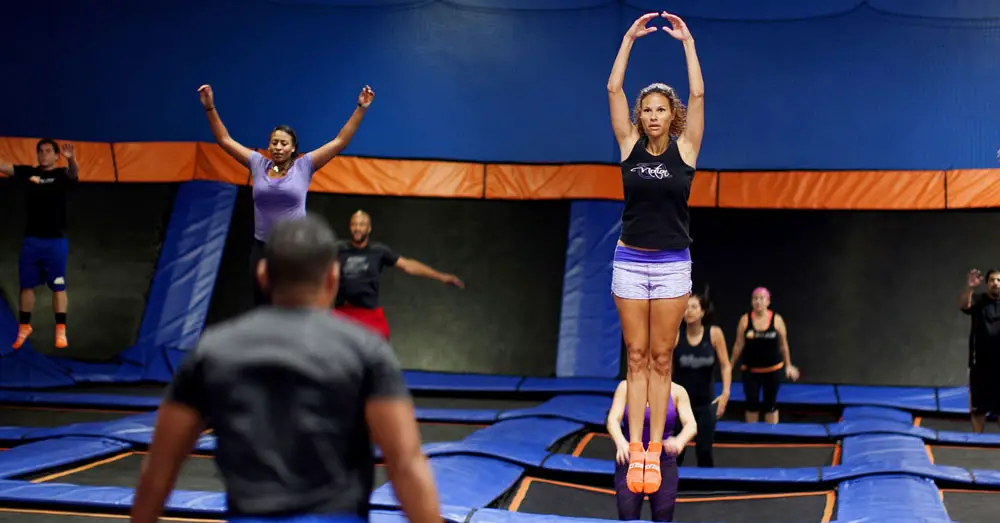Trampoline Parks Offer an Attractive Business Opportunity

In the last 10 years have quickly become the fastest growing type of family entertainment center around. These parks offer a fun, community based means of active entertainment. If you're interested in a high profit, health based, and safety oriented industry then read on.
Because of the rapid growth, the trampoline park landscape can be tricky to navigate. This article will serve as a beginners guide. You'll learn the basics of the business, opportunities in franchising, where to start building your park and more. Regardless of your location or vision, keep reading to get started!
Why Start a Trampoline Park Business?
The reasons for opening a trampoline park facility are diverse. The undeniable fact is these parks are an attractive business opportunity. The fun, active, and family friendly approach is attractive for many entrepreneurs.
The high accessibility for kids and adults pairs perfectly with the social and exercise based aspects. These aspects align well with societies shift to being health conscious, and paying for experiences rather than things. This future-oriented approach makes these locations a great long-term investment.
Below are just a few reasons why people are turning to trampoline parks as a business venture:
- Fun, active, community based business.
- Many great franchise options available.
- Explosive industry growth.
- Potential for expansion.
- High revenue and healthy profit margins.
- Worldwide opportunity.
- Safety oriented operators and support organizations.
For more information, be sure to read our article outlining the history of the industry.
The Trampoline Park Business Model

image credit: Zero Gravity Zone
At it's core, a trampoline park is based on a per-guest time based facility use fee. Normally this translates into $8-15 per hour, per-jumper. Special events and activities can increase the revenue per jumper. Most facilities are designed to handle between 150-300 hundreds of jumpers at a time.
Kids and adults alike have a fantastic time at jump facilities. Foam pits and open jump might attract the youngsters while dodgeball leagues and fitness programs are perfect for the older crowd.
The main revenue streams of trampoline parks come from three places:
- Purchase of regular jump time.
- Birthday party and event hosting.
- Special programs and events.
These parks have proven to be a high-profit venture with room to expand into neighboring activities. The standard figure is for trampolines to account for roughly 50% of the available space. By utilizing the remaining space and keeping an open mind to facility expansion, parks can expand revenue sources with additional activities and attractions.
Staffing
Most parks staff a core full time group with a larger additional part-time crew. This balance allows parks to run limited hours on slow days, stay flexible for special events and run the day-to-day operations.
Target Demographic Market
5-30 yr olds with birthdays being the centerpiece. Most locations are open limited hours during the week with a focus on Friday through Sundays where the bulk of their business takes place. Special time periods like holidays, spring break, and any non-school day are especially busy and profitable for jump parks.
Facility and Investment Requirements
Before entering any venture, its always best to understand the commitments required of you. This section will help you understand what to expect from a facility, financial and market perspective. Each of the following sections will help you paint a clear picture of your business goals.
All of the figures below are based on industry averages. Specific figures should be reached by working with a franchise partner or doing in-depth research for your project.
Facility Needs
- Building sizes between 20,000 and 40,000 square feet. (1858 - 3716 square meters)
- Trampoline equipment accounts for roughly 50% of building square footage.
- Main area consisting of roughly 60 interconnected trampoline surfaces.
- ASTM standards require a 17 foot (5.2 m) ceiling height from slab to lowest obstruction in the ceiling.
Investment and Return Figures
- Initial investment of between $1.5 to $3 million in capital.
- Return on investment between 10 - 18 months.
- Labor costs at or below 5% family entertainment center averages.
- Successful businesses running at 20% ROI or more.
Franchise Costs
The following fees will give you a ballpark figure for what to expect:
- Average of $50,000 upfront franchise fee.
- 6% of gross revenue.
Safety Standards
The trampoline industry has historically been self-regulated from a safety standpoint. In 2012 industry players came together to create the International Association of Trampoline Parks. In 2013 ASTM International released their first set of safety standards which were later updated in 2015. Any new trampoline park business operator should consider IATP membership and study the ASTM standards.
We've covered safety information more in-depth in our article on the topic.
Should I Franchise or Start a New Company?
Once you've decided that you'd like to look into an indoor trampoline facility as a business venture, its time to make an important choice: "Do I franchise, or build my own?"
From 2010 - 2016 the number of parks exploded. This is great because it means the wealth of opportunity is large. The downside is some markets are already over-saturated. The future will be interesting for competition between parks and franchises.
Depending on your preferences, priorities, and location being a nimble self-owned operation might make sense. On the other hand being backed by a strong franchise partner can give you some strength to weather the storm. Regardless of your preference we strongly suggest investigating the market thoroughly.
The Blurry Line Between Trampoline Park and Family Entertainment Center
Despite the coined term "trampoline park", many facilities and franchise operations are expanding beyond just trampolines. Many locations are now offering a much wider variety of attractions. As the market begins to saturate, a multi-attraction facility is becoming one of the best ways for competitors to set themselves apart and attract a larger client base.
Core trampoline park offerings commonly include:
- Main Jump Area
- Dodgeball Courts
- Foam or Air Bag Pit
- Basketball Dunk Lanes
Facilities with multiple attractions could easily be categorized under family entertainment centers (FEC), family fun centers, or even adventure parks. No matter what you call it, the definitions are quickly becoming blurred. It is important to think well into the future when it comes to the size of your location and expansion possibilities.
Additional family fun center offerings often include:
- Arcades
- Food Courts / Snack Bars
- Ninja Obstacle Courses
- Laser Tag
- Go-Karts
- Rock Climbing
- Indoor Roller Coasters
- Indoor Skydiving
- Anything else you might imagine!
It is important to note that in most cases multi-attraction facilities still see 50-60% of their revenue stemming from the trampoline park offering.
Designers, Manufacturers, and Builders
Regardless of your approach to the business, it's important to research the design and construction aspects. If you're going with a franchise partner, they will likely provide assistance or offer design and builder advice. Either way, we've collected a list of trampoline park builders for your convenience.
Trampoline Park Franchise Options
We've collected all the franchises available across the USA. You can browse a full listing of trampoline park franchise options in our franchise section. We also list the associated franchise (if any) on each park profile in our database.
Share this Article:

Thank you for this valuable information. I thought you might like to know that your metric conversions are not calculated accurately. You may want to take a look at that. 20,000 - 40,000 square feet would come to 1858 m2 - 3716 m2. Again, thank you. All the best to you, Shannon
Hello Shannon, thank you for catching the error! It's been corrected.